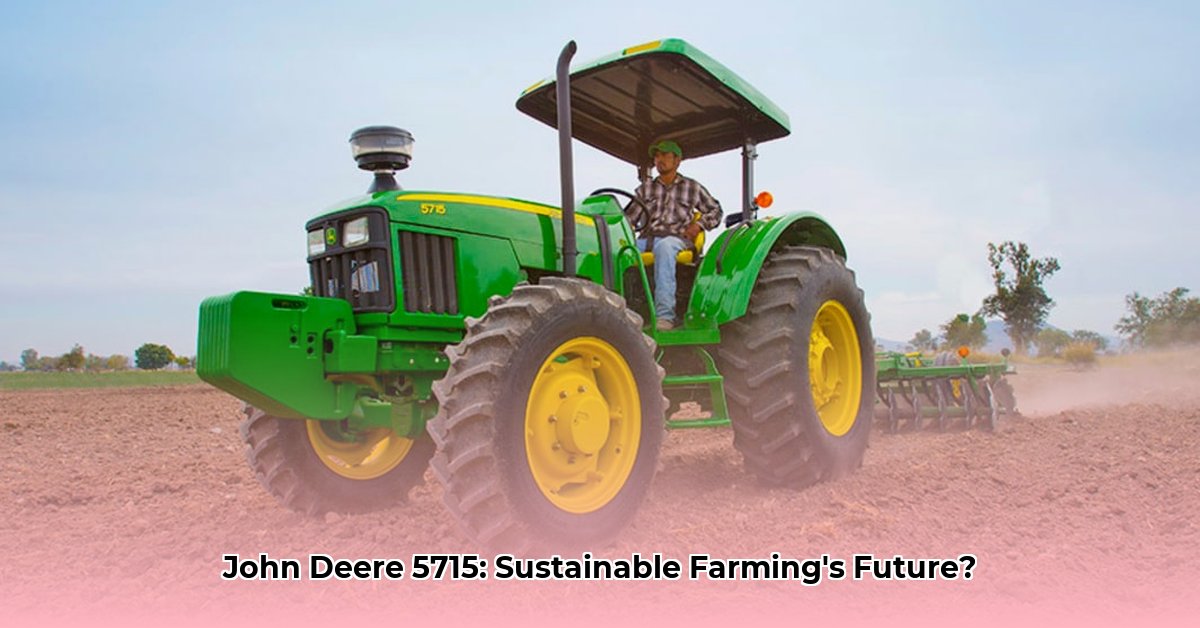
Tractor John Deere 5715: A Deep Dive into Sustainability
Thinking about purchasing a John Deere 5715 tractor? This comprehensive review analyzes its performance, cost, and—crucially—its environmental impact, helping you determine its suitability for your sustainable farming goals. We’ll examine fuel efficiency, operational features, long-term costs, and offer comparisons to help you make an informed decision. The John Deere 5715, with its potential for fuel efficiency, presents an interesting case study within the context of sustainable agricultural practices. However, a thorough assessment requires a frank examination of both its strengths and weaknesses. For more on John Deere tractors, see this helpful resource: John Deere Tractors.
Performance and Fuel Efficiency: Real-World Fuel Consumption
The John Deere 5715 boasts a generous 95-liter fuel tank, promising extended operation. But how does its real-world fuel consumption compare to competitors? Manufacturer claims require verification through independent testing and user feedback. Currently, this data is limited; further research involving real-world fuel usage data from multiple users operating under varied conditions is needed to accurately assess its fuel efficiency. Isn't independent data crucial before making such a significant investment?
Operational Efficiency and Features: Productivity and Precision
The 5715's 9 forward and 3 reverse gears facilitate smooth speed transitions, potentially improving efficiency. Its ergonomic design prioritizes operator comfort, reducing fatigue and enhancing focus. The optional JDLink™ system (a telematics system providing real-time data monitoring) offers valuable insights into fuel usage, location, and engine performance. This data-driven approach can help identify inefficiencies and optimize operational practices. However, the subscription cost for JDLink™ must be factored into the overall cost analysis. What is the return on investment for JDLink™, considering its subscription cost?
Maintenance and Long-Term Costs: A Critical Data Gap
A major shortcoming in assessing the John Deere 5715 is the lack of readily available data on maintenance costs. This information—including intervals, repair frequencies, and parts pricing—is crucial for determining the total cost of ownership (TCO). Proactive maintenance (regular servicing) is paramount for extending the tractor’s lifespan and minimizing unforeseen expenses. Before purchasing, contact John Deere dealers to obtain estimates and plan for these costs. How can farmers effectively budget for maintenance when crucial cost data remains unavailable?
Sustainability Assessment: Environmental Impact and Data Transparency
While the potential for fuel efficiency suggests a reduced carbon footprint, a comprehensive lifecycle assessment (LCA) is needed to fully evaluate the environmental impact. A thorough LCA would analyze greenhouse gas emissions, soil health impacts, water usage, and manufacturing processes. Currently, this data is limited, highlighting a vital area for future research. Without this assessment, can we fully claim the tractor's commitment to sustainability?
Comparison to Alternatives: Holistic Sustainable Practices
To fully evaluate the John Deere 5715, consider comparing it to competing models. Look at fuel efficiency, features, maintenance costs, and their respective environmental impacts. Some alternatives may offer similar performance with better sustainability credentials. This comparative analysis reinforces the need for comprehensive data for all agricultural machinery. “A thorough comparison requires standardized metrics for sustainability across different manufacturers,” notes Dr. Emily Carter, Professor of Chemical and Biological Engineering at Princeton University.
Conclusion: Potential and the Need for Transparency
The John Deere 5715 demonstrates potential for sustainable farming, particularly through its efficiency features. However, the absence of comprehensive data on maintenance costs and environmental impacts limits a complete assessment. Further research is needed to fill these crucial gaps. This openness about data limitations underscores the importance of transparency in the agricultural equipment sector.
Actionable Recommendations: A Multi-Stakeholder Approach
The following recommendations target different stakeholders to address the identified challenges:
1. Farmers: Request fuel consumption data from owners. Investigate JDLink™ costs and potential ROI. Track total cost of ownership meticulously. Explore alternative sustainable farming methods.
2. John Deere: Publish detailed lifecycle assessments and maintenance guidelines. Invest in research to improve fuel efficiency and reduce environmental impact.
3. Researchers: Conduct independent field tests and comparative analyses. Develop standardized methodologies for measuring tractor sustainability.
4. Government Agencies: Promote incentives for fuel-efficient machinery. Support research into sustainable agricultural technologies and practices.
Navigating the Risks: Informed Decision-Making
| Risk Factor | Probability | Impact | Mitigation Strategies |
|---|---|---|---|
| JDLink™ System Issues | Moderate | Moderate | Thoroughly research system reliability and security. |
| Fuel Price Volatility | High | High | Diversify fuel sources; explore alternative fuels. |
| Unexpected Repairs | Low | High | Implement robust preventative maintenance; explore extended warranties. |
| Parts Availability | Low | Moderate | Research parts availability in your region. |
Ultimately, the John Deere 5715's suitability depends on your individual needs and priorities. Sustainable farming requires a holistic approach; the tractor is just one component. Make informed decisions based on the available information and the identified data gaps.